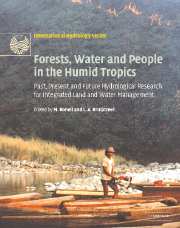 Forests, Water and People in the Humid Tropics
Forests, Water and People in the Humid Tropics Book contents
- Frontmatter
- Contents
- List of contributors
- Foreword
- Preface
- Acknowledgements
- Symposium and Workshop
- Introduction
- Part I Current trends and perspectives on people–land use–water issues
- Part II Hydrological processes in undisturbed forests
- Part III Forest disturbance, conversion and recovery
- Part IV New methods for evaluating effects of land-use change
- 27 Remote sensing tools in tropical forest hydrology: new sensors
- 28 Detecting change in river flow series
- 29 How to choose an appropriate catchment model
- 30 The disaggregation of monthly streamflow for ungauged sub-catchments of a gauged irrigated catchment in northern Thailand
- 31 Parsimonious spatial representation of tropical soils within dynamic rainfall—runoff models
- 32 Isotope tracers in catchment hydrology in the humid tropics
- 33 Process-based erosion modelling: promises and progress
- 34 Impacts of forest conversion on the ecology of streams in the humid tropics
- Part V Critical appraisals of best management practices
- Conclusion: Forests, water and people in the humid tropics: an emerging view
- Plate section
- References
29 - How to choose an appropriate catchment model
from Part IV - New methods for evaluating effects of land-use change
Published online by Cambridge University Press: 12 January 2010
- Frontmatter
- Contents
- List of contributors
- Foreword
- Preface
- Acknowledgements
- Symposium and Workshop
- Introduction
- Part I Current trends and perspectives on people–land use–water issues
- Part II Hydrological processes in undisturbed forests
- Part III Forest disturbance, conversion and recovery
- Part IV New methods for evaluating effects of land-use change
- 27 Remote sensing tools in tropical forest hydrology: new sensors
- 28 Detecting change in river flow series
- 29 How to choose an appropriate catchment model
- 30 The disaggregation of monthly streamflow for ungauged sub-catchments of a gauged irrigated catchment in northern Thailand
- 31 Parsimonious spatial representation of tropical soils within dynamic rainfall—runoff models
- 32 Isotope tracers in catchment hydrology in the humid tropics
- 33 Process-based erosion modelling: promises and progress
- 34 Impacts of forest conversion on the ecology of streams in the humid tropics
- Part V Critical appraisals of best management practices
- Conclusion: Forests, water and people in the humid tropics: an emerging view
- Plate section
- References
Summary
INTRODUCTION
The existence of a large number of catchment hydrology models, evident from even a cursory glance at the literature, is likely to cause trepidation or confusion for even expert modellers, let alone practitioners of hydrology who merely require something ‘off the shelf’ which they can use with confidence. Typically, available catchment models often come with exaggerated claims for the breadth of their applicability, and little or no in-depth discussion of their inherent assumptions and consequent limitations. Two questions will therefore be addressed in this chapter:
How can an appropriate model for my catchment be chosen, given an intended application? and
How can an appropriate model be constructed (or an existing model be modified) if none exists at present?
There would appear to be several reasons for the present wide range of models, including:
a diverse range of catchments and purposes (for example, forecasting or regulatory support) which in turn implies interest in many different kinds of processes;
availability of different levels of information or data quantity and quality; and
the fact that catchments are complex systems, having a huge number of potentially significant processes, and consequently ‘emergent behaviour’ (defined later on) which is not evidently a simple sum of the component parts.
Taken together, these three factors imply that to represent catchment behaviour efficiently, much of what is deemed to be of secondary importance must inevitably be either ignored or greatly simplified by using specific assumptions.
- Type
- Chapter
- Information
- Forests, Water and People in the Humid TropicsPast, Present and Future Hydrological Research for Integrated Land and Water Management, pp. 717 - 741Publisher: Cambridge University PressPrint publication year: 2005
References
- 3
- Cited by
